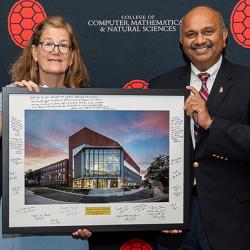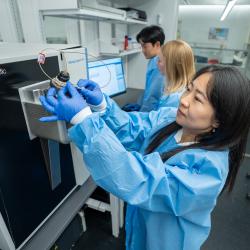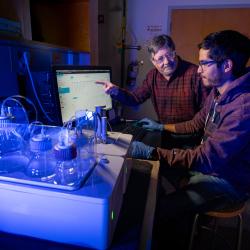Big Questions In Science- 6) How does energy flow between fast-spinning molecules?
When Chemistry Professor Amy Mullin's research on high energy molecules reached an impasse, she did what great scientists have done throughout the ages—developed her own instrumentation to help her seek answers. For years, chemists have investigated how energy flows between molecules, hoping to gain insights into how chemical reactions work, but one type of molecular energy—rotation—has remained elusive. Until Mullin developed a high power optical centrifuge, no tool existed to move enough molecules into the extreme states required for study. Understanding these high-energy molecules could have far-reaching insights into plasma and combustion processes.
The optical centrifuge works by using a special combination of ultrafast laser pulses—called oppositely chirped pulses—to spin molecules into extreme rotational states. “It mimics molecules found under extreme temperature conditions in nature—several thousand degrees Kelvin,” explains Mullin. “But unlike nature, the centrifuge gets the molecules rotating uniformly in space similar to many tiny, spinning gyroscopes. This gives us the potential to control the direction of reactive molecules.”
The experiment fills an entire laboratory with its series of contraptions and mechanisms —oscillators, amplifiers, lenses and mirrors— covering three connected tables, encompassing 150 square feet. The centrifuge itself covers the first two tables; the final third contains the instrumentation for high-resolution infrared spectroscopy. “The spectroscopy allows us to study how the rotational energy is redistributed into other forms of energy through collisions,” says Mullin.
Mullin joined CMNS in 2005 from Boston University with the dream of building this revolutionary tool. Despite naysayers in the scientific community, Mullin designed, built and began operating the centrifuge in four years. The working instrumentation wowed NSF, which granted Mullin funding to continue the project.
Her research is just beginning to yield insights into the dynamics at play in these molecules. “What’s surprising,” says Mullin, “is that once we get the molecules spinning, the spin persists even after several thousand collisions. Then it goes into translational energy.” With varied molecular compounds behaving somewhat differently, Mullin’s graduate and undergraduate student team members have their work cut out for them. “We have to take a lot of measurements to sort out the general from the specific,” says Mullin. “But we have already sparked the imagination of many chemists and physicists by showing that we can put these molecules into extreme states.”
Writer: Beth Panitz







